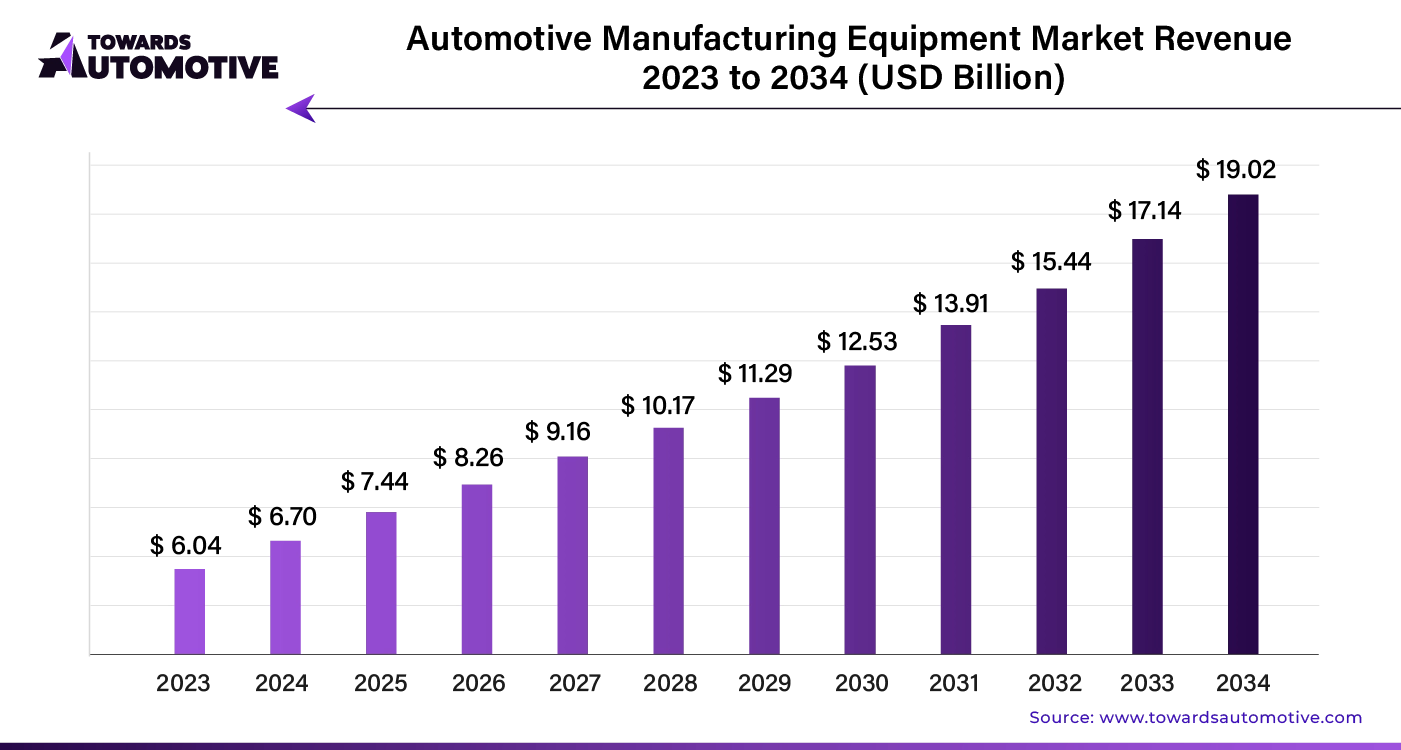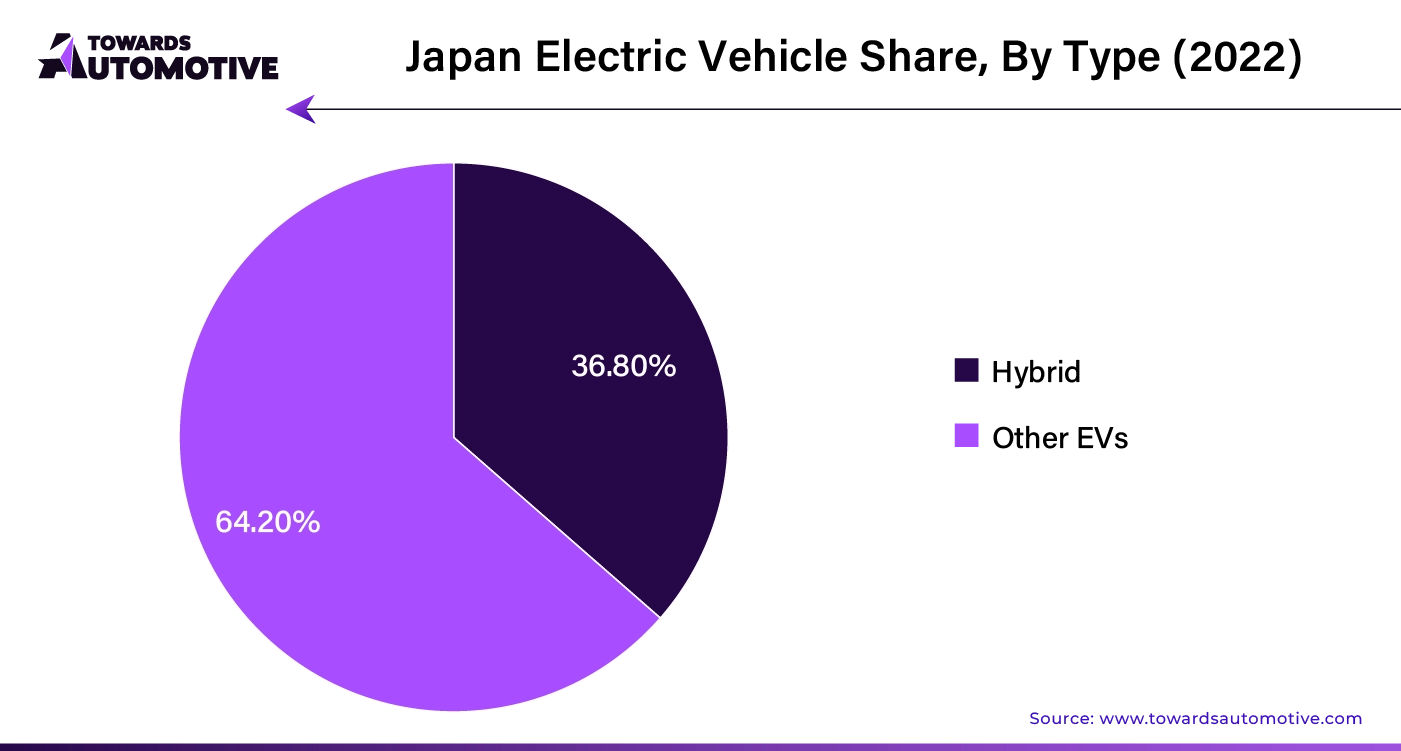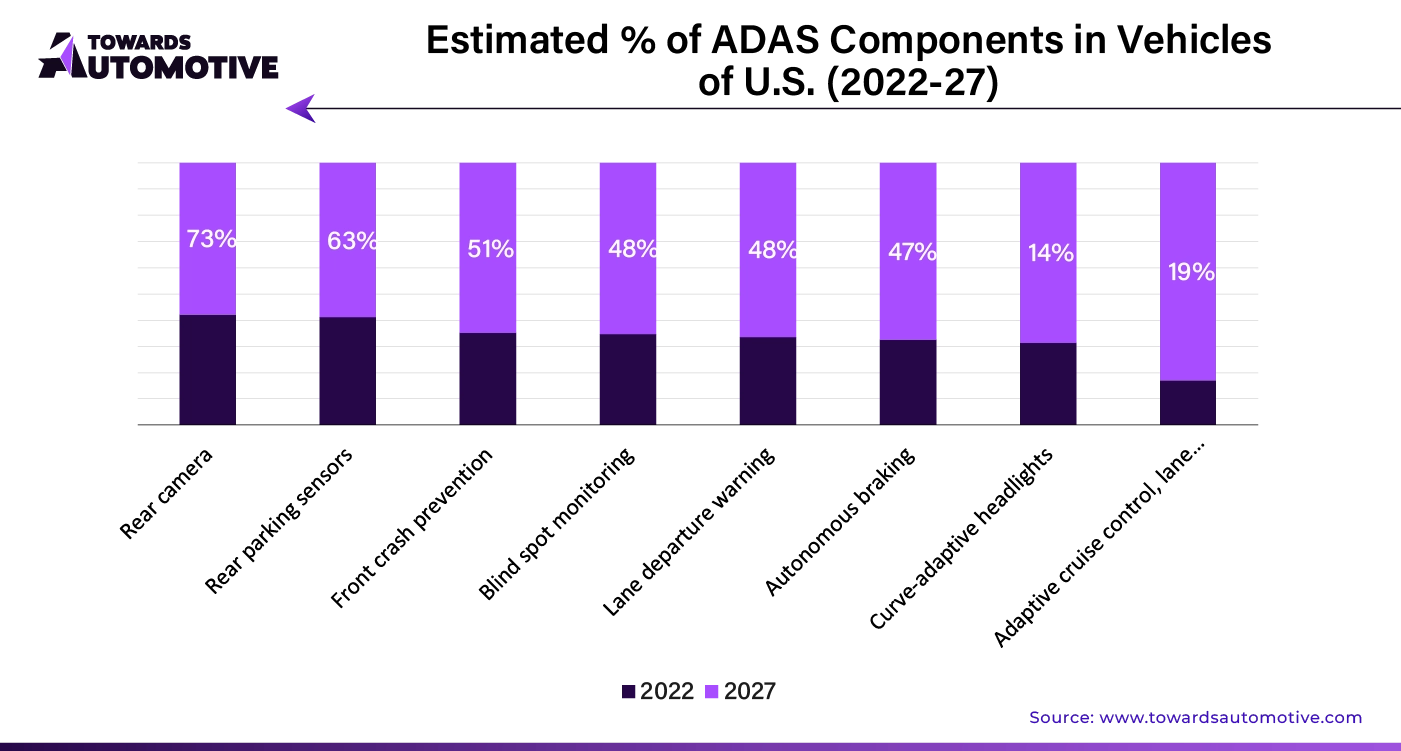April 2025
The global automotive manufacturing equipment market size is calculated at USD 6.70 billion in 2024 and is expected to be worth USD 19.02 billion by 2034, expanding at a CAGR of 11.00% from 2023 to 2034.

Unlock Infinite Advantages: Subscribe to Annual Membership
Demand for conveyor belts remains robust due to their essential role in transporting materials and parts in the automotive sector. The automotive manufacturing equipment market, which includes a range of machines, devices, and tools, is experiencing strong growth and is expected to continue expanding through 2034.
The automotive industry’s push for greater productivity and lower labor costs is accelerating the adoption of automation. This trend is likely to drive increased sales of manufacturing equipment throughout the assessment period. The automotive market valued at USD 4,070.19 billion in 2023, is experiencing growth and is projected to surpass USD 6,678.28 billion by 2032, with a significant CAGR of over 5.66%.
Automakers are increasingly using advanced technologies to enhance productivity, improve product quality, and cut labor costs. This shift is set to further propel the automotive manufacturing equipment market.
Key equipment widely used in the sector includes conveyor belts, bending machines, stamping presses, CNC machines, grinding machines, and drilling and milling machines. Additionally, welding robots, assembly robots, painting robots, and coordinate measuring machines (CMMs) are also integral to the industry.
Leading manufacturers are expanding their product lines with innovations like smart robots and advanced CNC machines. For example, in November 2023, Yaskawa Electric Corporation launched the MOTOMAN NEXT series, featuring robots with autonomous environmental adaptability and advanced decision-making capabilities.
The automotive manufacturing equipment market is experiencing significant growth due to several key factors:
The global automotive manufacturing equipment market is rapidly evolving due to key trends:
The automotive industry is increasingly turning to lightweight materials such as carbon fiber, aluminum, and advanced composites. This shift, driven by the demand for fuel-efficient vehicles and environmental concerns, is expected to enhance the market for specialized manufacturing equipment. The unique properties of these materials require tailored manufacturing processes.
The automotive sector is transitioning from internal combustion engines to electric and hybrid vehicles. This shift is likely to increase the demand for new manufacturing equipment designed for the different assembly processes and requirements of these vehicles.
To stay competitive, leading companies are introducing advanced production machinery and robots. For example, YASKAWA launched the MOTOMAN-GP300R shelf-type robot in April 2020. This robot is designed to streamline assembly processes for lightweight and eco-friendly vehicles, optimizing space and increasing production efficiency.
AI integration is transforming the automotive manufacturing equipment market by driving innovation and efficiency. AI technologies enhance predictive maintenance, allowing for real-time monitoring and diagnostics of equipment. This proactive approach minimizes downtime and reduces maintenance costs, significantly boosting productivity. Machine learning algorithms analyze vast amounts of data from manufacturing processes to optimize production schedules and improve quality control. This results in more precise and efficient manufacturing, lowering defect rates and increasing overall output.
AI also plays a crucial role in automating complex tasks, from assembly line operations to quality inspections. Robotics powered by AI adapt to varying production needs and handle intricate processes with high accuracy. This not only speeds up production but also reduces human error, contributing to higher consistency and reliability in automotive parts.
Furthermore, AI-driven analytics provide valuable insights into market trends and consumer preferences, enabling manufacturers to adapt quickly and stay competitive. As AI technologies continue to evolve, their integration will further enhance operational efficiency and innovation in the automotive manufacturing sector, driving sustained market growth.
In the automotive manufacturing equipment market, an efficient supply chain is crucial for success. Key players must streamline logistics to ensure timely delivery of parts and components. This involves close collaboration with suppliers to manage inventory levels, minimize delays, and reduce costs.
The supply chain starts with raw materials, which are sourced from reliable suppliers. Manufacturers then process these materials into parts and assemble them into equipment. Effective coordination between procurement, production, and distribution ensures that each stage of the supply chain operates smoothly.
Technological advancements play a significant role in optimizing supply chains. Automation and real-time tracking systems enhance visibility and coordination, allowing manufacturers to anticipate and address potential disruptions quickly. Furthermore, implementing just-in-time (JIT) inventory systems helps in reducing holding costs and improving cash flow.
Overall, a well-managed supply chain in the automotive manufacturing equipment market not only boosts operational efficiency but also strengthens competitive advantage by delivering high-quality products on time and within budget.
The Automotive Manufacturing Equipment market thrives on several key components: assembly lines, robotics, tooling, and testing equipment. Each component plays a critical role in streamlining production and ensuring vehicle quality.
Robotics, used for welding, painting, and assembly, enhances precision and efficiency. Companies like ABB and KUKA lead in robotics, offering advanced solutions that reduce manual labor and increase production speed. Tooling, including stamping and machining tools, is essential for shaping vehicle parts. Leaders such as Bosch and Siemens provide high-performance tooling systems that ensure accuracy and durability.
Assembly lines, integral to mass production, are optimized by companies like Durr and Fanuc. They design systems that minimize downtime and maximize throughput. Testing equipment, crucial for quality control, is advanced by firms like AVL and MTS Systems. Their technology ensures that vehicles meet safety and performance standards before reaching the market.
Overall, these components and companies collectively drive the automotive manufacturing ecosystem, fostering innovation and efficiency in vehicle production. Their contributions shape the industry, ensuring high-quality vehicles and streamlined manufacturing processes.
The automotive manufacturing equipment market is experiencing notable growth across various countries, each contributing uniquely to the global landscape.
United States: Market Leader The United States leads the market, with an estimated value of $3.6 billion by 2034. The country maintains its dominance due to its rapid adoption of Industry 4.0 technologies, such as automation, AI, and robotics. The shift towards environmentally friendly vehicles and the emphasis on manufacturing efficiency further drive this demand. Advanced technologies like robotics are becoming increasingly popular, with a notable rise in their application across welding, painting, and assembly tasks. This technological evolution and government support are expected to bolster the market throughout the forecast period, with a compound annual growth rate (CAGR) of 11.4%.
China: Rapid Growth China is experiencing the fastest growth in the automotive manufacturing equipment market. With an anticipated market value of $3.3 billion by 2034 and a robust CAGR of 12.3%, China’s growth is fueled by its booming automotive sector and extensive use of automation. Government initiatives, such as the five-year plan to become a global robotics innovation hub, are accelerating the adoption of advanced manufacturing technologies. The country's strong robotics industry and growing vehicle export rates are pivotal in driving this rapid expansion.
Japan: Steady Progress Japan’s automotive manufacturing equipment market is set to reach $2.2 billion by 2034, with a steady CAGR of 12.0%. The transition towards electric and hybrid vehicles, combined with the demand for lightweight materials and advanced manufacturing technologies, is propelling this growth. Japan’s focus on innovation in automotive equipment and stringent environmental regulations are also contributing factors. The increasing need for specialized testing equipment and smart manufacturing solutions underscores Japan's commitment to maintaining its competitive edge.

South Korea and the United Kingdom: Emerging Players South Korea and the United Kingdom are also noteworthy contributors, with expected market values of $1.3 billion and $810 million, respectively. South Korea is projected to grow at a CAGR of 13.5%, driven by advancements in automation and robotics. The United Kingdom follows with a CAGR of 12.5%, benefiting from its rising adoption of Industry 4.0 technologies and government initiatives supporting manufacturing innovation.
Conveyor Belts: The Fastest-Growing Segment
The conveyor belt segment is projected to grow at a robust compound annual growth rate (CAGR) of 10.8% from 2024 to 2034. Conveyor belts are gaining popularity due to their ability to enhance material handling and streamline production processes. Their continuous operation, reduction in labor costs, and improved production efficiency make them highly sought after. Additionally, their versatility and seamless integration with automation systems further drive their demand.
As the automotive industry advances, the need for efficient manufacturing solutions becomes more pressing. Conveyor belts meet these needs effectively with their adaptability and cost-effectiveness. They can be tailored to various configurations, enabling manufacturers to adjust systems with minimal disruption. The rising demand for durable, low-maintenance conveyor belts aligns with the industry's push for increased production efficiency.
Passenger Vehicles: The Dominant Segment
The passenger vehicles segment continues to lead the automotive market, with an anticipated growth rate of 10.3% CAGR over the same period. This segment benefits from a higher global demand compared to commercial vehicles. Passenger vehicles, including SUVs and sedans, have specific production requirements and shorter lifespans, leading to consistent replacement and ongoing manufacturing needs.
Emerging technologies such as advanced driver-assistance systems (ADAS), electric vehicles, and autonomous driving are driving the need for specialized equipment in this segment. As passenger vehicles evolve, the demand for innovative manufacturing solutions is expected to rise.

The automotive manufacturing equipment market is fiercely competitive, with numerous players driving innovation and technological advancement. Leading manufacturers are consistently developing cutting-edge solutions, such as advanced automotive robots and CNC machines, to maintain their edge.
Companies in this sector are adopting various strategies, including partnerships, facility expansions, acquisitions, and collaborations, to enhance their market presence and revenue. They are also actively participating in industry exhibitions and events to broaden their customer base.
By Equipment Type
By Vehicle Type
By Region
April 2025
April 2025
April 2025
April 2025
We offer automotive expertise for market projections and customizable research, adaptable to diverse strategic approaches.
Contact Us